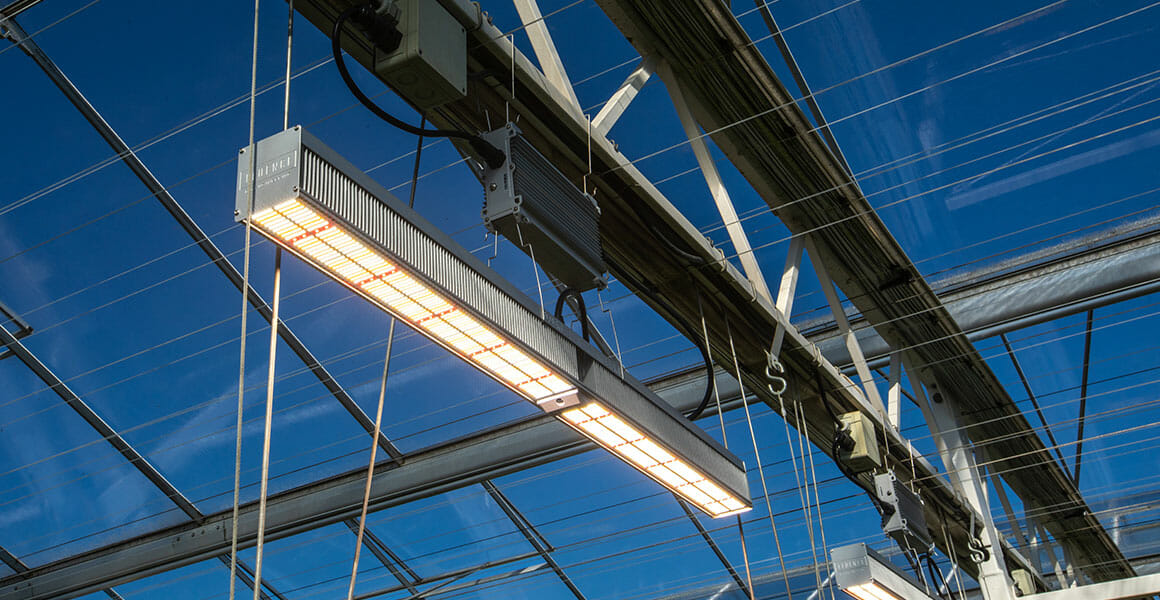
We know which spectra are best for different greenhouses, but what role do your fixtures play?
07 Oct Choosing the Right LEDs for your Greenhouse Part II: Fixtures
In Part I, we discussed the spectral output of LED lights and the impact that various spectra can have on crop yield and output (as well as on all life that thrives inside your greenhouse).
Understanding which type of LED lighting to use is necessary when retrofitting a greenhouse or developing a hybrid system of HPS and LED lighting, but growers also need to consider the fixtures themselves.
Selecting the right fixture
Considerations like natural light, energy prices and other factors influence the selection process. Fluence offers a wide range of fixtures (and spectra) to assist any operational goals.
In addition to these considerations, growers must weigh the advantages and disadvantages of the fixtures they will install and how those fixtures can meet or exceed cultivation goals for plant response, operational or environmental conditions, and top-line performance. There are four parameters to consider when evaluating LED fixtures.
1. Spectra and their association to DLI
As discussed in Fluence Greenhouse LED Retrofit Guide , there are two main categories of spectra that growers must evaluate before any LED implementation: narrow-band and broad-band.
These spectra options are targeted to support a given crop’s need for additional light or to elicit specific photoresponses and morphology. From an energy efficiency standpoint, narrow-band spectra often have the upper hand but should only be used when growing cultivars and crops that respond less effectively to a broad spectrum. For example, adopting a narrow-band approach to a cultivar like Merlice tomatoes that perform better under broad-spectrum light would eliminate any gains in overall efficiency due to decreased crop yield and/or quality.
Moreover, narrow-band spectra can be detrimental to crops grown in regions with low DLI during winter months. Isolated spectra will often spur suboptimal morphology in the wrong conditions.
Growers should consider broad-spectrum strategies in regions where DLI is lower, where circumstances demand it, when crops require or prefer higher PPFD, or when growing crops proven to respond better to white light than to pink light. In addition to improved plant performance, a broad-spectrum strategy carries other holistic benefits such as improved workplace conditions.
In the end, growers should not overemphasize electricity prices. They should instead focus on how specific spectral strategies can impact their crops in terms of yield, morphology and production because the earning potential of LEDs often outweighs their significant money-saving potential.
2. Maximum light distribution
Growers will discover that recent LED design technology complements existing greenhouse infrastructure quite well, allowing crops to receive more natural sunlight.
PPFD levels tend to rise when greenhouses transition to LED fixtures. This begs the question, “How can I uniformly distribute this added PAR or mimic HPS distribution patterns to achieve maximum results?”
To start, growers will want to know their legacy system’s photosynthetic photon intensity distribution (PPID). While some systems might be optimized from the outset, others may struggle to achieve uniform distribution if LEDs are placed directly with HPS fixtures, as the beam angle of LED technology is more direct. Growers also must account for placing HPS lights farther away from the canopy than LEDs since they emit more heat. Fluence’s LED fixtures can be especially helpful for those with low ceiling lights, especially when paired with a reflector that increases PPID.This problem is easily solved with the correct technology and information.
At Fluence, our lighting designers work directly with growers to assess current distribution based on elements like lighting placement and system output.
Fluence VYPR fixtures feature a reflective adapter to properly distribute light at a lower level across the canopy and to widen the coverage area. To further modulate distribution, VYPR’s mounting hardware is available in six configurations.
In the past, the high IR output of HPS lamps made it difficult to supplement lighting under low-height ceilings. Now, LEDs allow lower-height facilities to improve their light levels without the risk of damaging equipment or burning crops.
3. Superior fixture cooling
Lighting presents a fundamental issue in the form of heat. Even LED lights generate some heat at their junctions to the printed circuit board. That heat can affect the output and longevity of LED fixtures that lack a cooling system.
Some LED manufacturers build cooling systems into their fixtures by either circulating a liquid coolant through the fixture or by installing an electric fan to circulate air across a heat sink. Others lack cooling systems altogether. There are drawbacks to both approaches.
Most cooling systems can reduce LEDs’ efficiency or pose a major risk to the equipment should the cooling systems fail and leave the fixtures vulnerable to heat. Active cooling systems reduce the overall photon efficacy of the fixture because the cooling fan or pump consumes power. Just as critically, active systems introduce new points of failure to the design.
Alternatively, Fluence VYPR fixtures employ a patented, passively-cooled thermal management technology that does not rely on moving parts. Instead, its vertical heat sink conducts heat upward and away from the circuit board and plants. Due to the large surface area of the heat sink, the VYPR can operate in ambient temperatures as high as 40 ℃ without reliability concerns.
4. Assuring fixture quality
Just as with any piece of hardware, LED fixtures are not all created equal. Cheap products can be less efficient and effective, and unreliable companies may not be around long enough to repair or replace broken equipment or honor warranties.
Fortunately, selecting a reliable LED fixture is easier than ever due to the diligent standards and reliability of the DesignLights Consortium®.
DLC is a nonprofit organization that sets quality specifications for energy-efficient lights and tests lights to ensure accurate PPE, PPF, PPID and spectrum. The DLC also simulates extended usage to estimate the PPF capacity after extended operation.
To confirm that an LED fixture is listed with the Design Lights Consortium, search the DLC Qualified Products List. You’ll also discover that Fluence has more products listed with the DLC than any other lighting manufacturer.
Find the premium LED fixtures you need at Fluence
Ready to find the right spectra and fixture for your needs? After you’ve searched the DLC’s qualified products list, reach out to us so that we can answer any questions you may have as you choose the right LED system to meet your unique needs and goals.


